What’s So Special About Bamberg?
Only one day in Bamberg? That’s enough to immerse yourself in this incredible Medieval city, and get a real flavor of life in the Middle Ages. From the mighty thousand-year-old cathedral, to the cobbled streets of the old town, to the best breweries Germany has to offer, it’s all here waiting to discover!
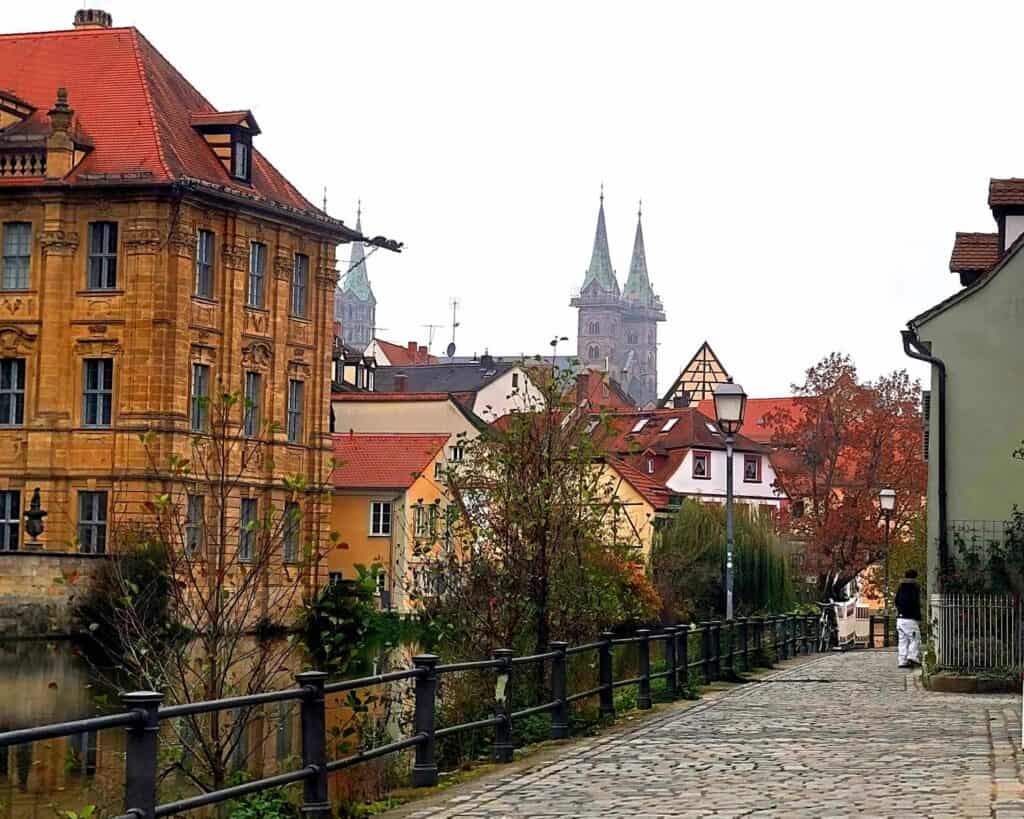
The incredible and historic city of Bamberg Germany lost only 4% of its buildings in the city center during World War II, so it retains all the original layout, architecture, and character of an atmospheric medieval city. Located in the north of the state of Bavaria, Bamberg stretches across seven hills, and sits at the confluence of the Regnitz and the Main (pronounced MINE) rivers.
The city center is very walkable, with most points of interest located close to each other. It’s also very bike friendly!
Bamberg is located in the cultural region of Franconia, which has no exact borders but spreads over parts of the states of Bavaria, Baden-Württemberg, and Thuringia. Franconia has its own culinary, cultural, and linguistic traditions.
And with 14 breweries in Bamberg proper, and 60 more in the surrounding area, it’s also Germany’s beer capital – and that’s saying something! This is what Bamberg is most famous for, and you can pop in and out of breweries to sample all the unique and delicious beers of the region, including its famous smoked beer called rauchbier.
Another unanticipated plus for Bamberg is the shopping! No big malls or outlets – just jaw-dropping antique stores; clothing boutiques, crafty gift shops, home decor, second-hand and antique books, and cozy cafés, beer gardens and wine bars to relax in after loading up your shopping bags.
How Long is Enough in Bamberg?

You could easily spend 2 full days in Bamberg, but if you are short on time, prepare ahead of time and hone down the list of things you want to see. A day trip from Nuremberg, Würtzberg, or Erfurt is easy and absolutely worth it!
Is Bamberg English-Friendly?
The people in Bamberg are incredibly friendly and helpful. Young people have impeccable English skills, and the older folks who don’t are happy to work with you (and your Google translate). I had a couple conversations with people who spoke about as much English as I did German (aka like a 5-year old) and everyone was laughing and got their point across just fine.
Bamberg definitely attracts its share of tourists, but most are from Germany! I mean, it’s the beer capital after all, and German’s love and appreciate good beer.
Is Bamberg Expensive?
We found Bamberg to be slightly above average for cost of hotel room, and expenses. But we did stay at a nice hotel with amenities, bought some cool souvenirs, and definitely ate and drank!
You can check out what the blog Budget Your Trip has to say about how much you can expect to spend in Bamberg, and how much things cost.
Is Bamberg Dog-Friendly?
Yes! Like all of Germany, Bamberg loves dogs. There are a few shops and restaurants that have ‘no dogs’ signs, but for the most part, well-behaved dogs are welcomed. You can certainly have your dog at a restaurant or biergarten with an outdoor area.
There are also many good choices for pet-friendly hotels in Bamberg and the surrounding area.
Seven Hills and Rough Cobblestones
One word of caution, though. Prepare yourself for a lot of up and down hills on rough cobblestones and uneven sidewalks, and also lots of stairs. There is a church on top of each hill, so to see them all – it’s a lot of up and down! Understand that this city, as charming and authentic as it is, is not the best choice for anyone using wheelchairs, or those with mobility issues.
And absolutely have a sturdy and well-cushioned pair of walking shoes. I walk in Europe a lot, but even in my usual walking shoes, my legs were feeling it, and my feet were hurting by the end of a day.
When is the Best Time to Visit Bamberg?

Many attractions close down for the season at the end of October and do not reopen until April. In summertime everything will be going full-swing, but also it will be the most crowded. The shoulder seasons of spring and fall are a great time to visit Bamberg because crowds are thinner, weather is still nice, and attractions are open.
And of course, the medieval backdrop and festive atmosphere make it the ideal place to head for a charming and authentic Christmas market! The market traditionally opens at the end of November, and runs through December 23.
*It’s always a good idea to plan your trip to Bamberg well beforehand if you want to be sure of getting a restaurant reservation, tour, or hotel room of your choice.
You can check the current weather conditions in Bamberg here.
The 14 Best Things to See in Bamberg!
You may not be able to see all of these things if you only have one day in Bamberg, but you’ll be able to check a lot of them off the list and make some fantastic memories.
1. Bamberg Cathedral (Bamberger Dom St. Peter und St. Georg)
Domplatz 1
Allow 30 minutes to an hour





Like many impressive Medieval buildings in Bamberg, we can thank Holy Roman Emperor Henry II for its construction. The Cathedral of St. Peter and St. George is an incredibly beautiful building containing numerous impressive sights both outside and within.
The cathedral took only 10 years to build, beginning in 1002 and completed in 1012, reaching an impressive height of 266 feet (81 meters). Its iconic four-towered construction is dramatic, and unique among German cathedrals.
After a fire destroyed much of the original structure, it was rebuilt between 1185 and 1237. The “new” renovation used a mix of Romanesque and early Gothic styles, and was completed in 1237. There have been minor restorations since then, but the cathedral’s structure is mostly true and unchanged since the 1200s!
Inside the cathedral are several things to look for. The Bamberg Horseman (Bamberger Reiter) is a famous early Gothic statue of a rider on a horse that dates to about 1230. The rider’s identity remains unknown, so the iconic statue maintains an air of romance and mystery, and has become kind of a mascot for the city.
Also look for the tombs of the royal couple Emperor Henry II and Empress Cunigund. In addition you’ll find the tomb of Pope Clement II, the only pope buried north of the Alps. Clement had been the Bishop of Bamberg before becoming Pope and requested burial in the cathedral with which he had such strong ties.
Admission is free, and opening hours are:
- Monday – Wednesday 9am-6pm
- Thursday – Friday 9:30am-6pm
- Saturday – 9:00am-4:15pm
- Sunday – 1:00pm-6:00pm
With one day in Bamberg, this iconic and historic building should top your list. And note the varying hours so you don’t miss out!
2. The Diocese Museum Treasury (Diözesanmuseum)
Domplatz 5
Allow 1 to 1.5 hours

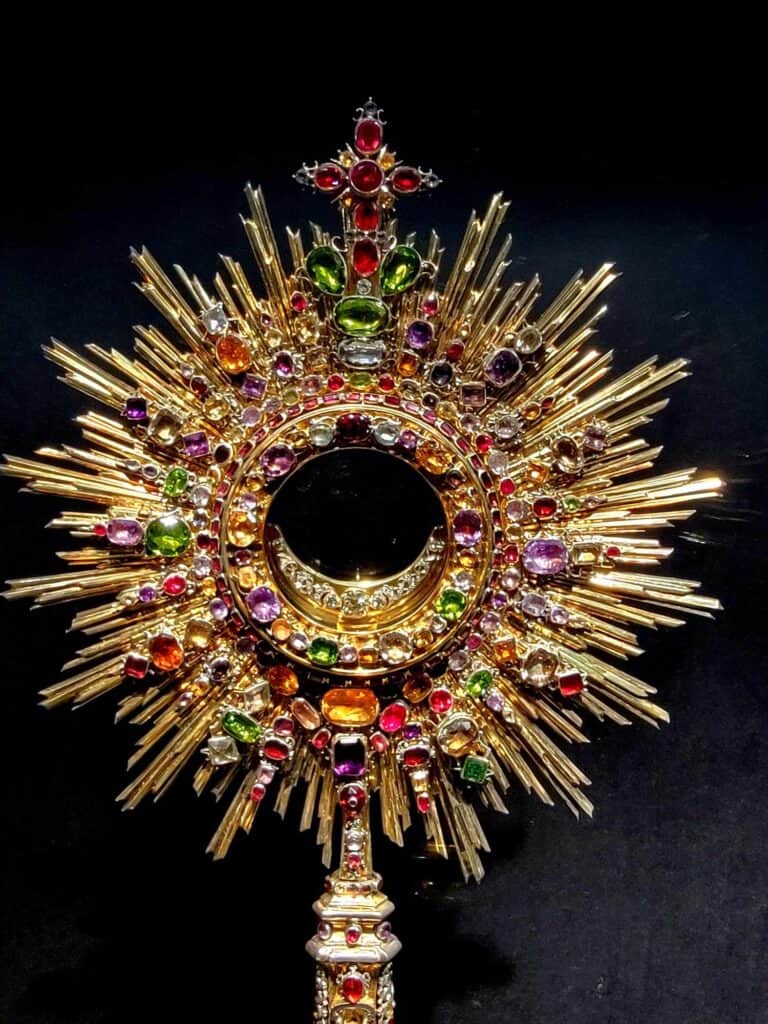




The Diocese Museum and Treasury is housed inside the historic buildings of the Old Court right in between the Bamberg Cathedral and the New Residence. It is chock full of the most valuable liturgical artifacts and medieval treasures associated with the diocese. The textile collection is one of the highlights, and showcases tunics, mantles, and other embroidered fabric that is over a thousand years old!!
The museum features many items associated with Holy Roman Emperor Henry II, and his wife the Empress Kunigund, both of whom were canonized into sainthood.
In addition you will find an incredible display of reliquary vessels, altar crosses, and liturgical vessels, and many statues and sculptures which were original to the cathedral, but have been moved to the museum to preserve them from natural degradation.
You’ll also be able to get up close and personal to some of the original 12th century stained glass from the cathedral. I really enjoyed being able to look closely at eye level in natural daylight at these incredible pieces.
- Monday and Tuesday 10:00 am – 5:00 pm
- Wednesday: closed
- Thursday and Friday 10am – 5pm
- Saturday 10:00am – 4:15pm
- Sunday 1:00pm – 5:00pm
Adult tickets are €7
Domberg Combo Ticket (includes Diocesan Museum, Historical Museum, and the New Residence) €12
3. Bamberg Beer: Self-Guided Tasting Tour
Bamberg is perfectly set up for a mini self-guided beer tasting tour that will get you to three amazing breweries in less than 100 steps! All have top-notch beer and great local food!
Bamberg is the kind of place where we really felt like going 100% German specialties, but we did notice a lot of Italian restaurants that seemed to be very popular.
Note that you don’t have to sit and eat to taste the beer. You can order a beer from a little station inside, pay a deposit on the glass, and just stand outside on the sidewalk with your fellow beer aficionados! There are always happy clusters of people on this block enjoying a brew, so you won’t feel alone!
If you do decide to eat, allow about an hour and a half, unless you want to stay longer. Reservations are always recommended, especially on weekends or during summertime.
Schlenkerla
Dominikanerstrasse 6
Reservations: +49 (951) 56050 or via email here





If you have time for only one brewery, Schlenkerla is definitely the one for its combination of history, ambiance, and authentic food. Bamberg’s signature beer is its rauchbier (smoked beer) which I adore. It’s probably not everyone’s taste, but it’s a bit like having a glass of beer with a hint of bacon, or a smoked whiskey cocktail… only beer. And the rauchbier from Scherlenka is the go-to in town.
We didn’t make a reservation but got lucky. They told us we could sit as long as we limited our stay to an hour and 45 minutes so the table would be ready for the next reservation, and we were fine with that. We stayed almost and hour and a half and that was plenty to eat and enjoy the beer.
The establishment has some major history behind it too. It’s not only been a brewery since 1405 when it was known as the House of the Blue Lion, they’ve annexed a building for seating space that used to be a Dominican monastery! After the building was secularized, it became part of the restaurant so you can grab a table inside the Dominikanerklause (from the year 1310!) with its painted arched ceilings, or the Bamberg Room which was also part of the monestary.
I enjoyed their local signature dish, the Bambergerzwiebeln mit Rauchbiersauße (don’t try to say that after a couple beers), which was a huge onion stuffed with seasoned ground pork, and a healthy mound of creamy mashed potatoes, all smothered in velvety smoked bier sauce. Absolutely perfect with the smoked beer!
My husband David had the schaufele (SHOY-fuh-luh) which is Frankonian fall-off-the-bone pork shoulder with crispy skin, gravy, and perfect fries.
Sponsored content: this section contains affiliate links
Ambrausianum
Dominikanerstraße 10
Reservations: +49 0951 5090262 or online at Ambrausianum’s website
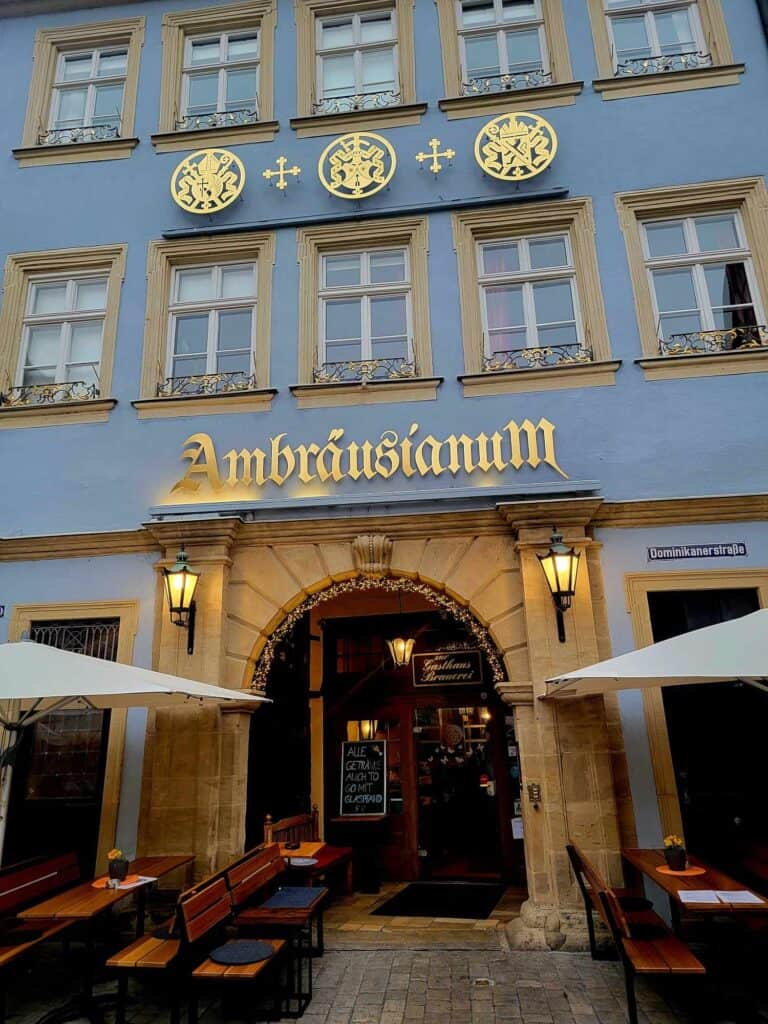


Right next door to Schlenkerla is Ambrausianum which was also great. It was very cozy with great atmosphere and extremely friendly service.
There are dark wood booths with beautiful seasonal decorations in the window nooks, and a huge copper beer vat near the entrance.
I had the flammküchen (a flat crispy bread with bacon, cream, and onion) with cheese and which they happily made half onion and half tomato. I normally don’t ask for special accommodations, but the server suggested it when he saw me struggling to make up my mind! And yes it was fabulous and the leftovers made a delicious midnight snack at the hotel!
David went for the traditional pork jägerschnitzel which is a thin breaded and fried pork fillet covered in mushroom cream sauce. And the fries were among the best I’ve ever had. Yes, I shamelessly stole a few!
And of course, more smoked beer! The table next to us had a flight of several different beers, but we decided to stick with what we both love!
Alt Ringlein
Dominikanerstraße 9
Reservations: +49 951 / 9532 0 or make reservations online here




Directly across the street from Schlenkerla is the third of the trio – Alt Ringlein. This place was right out of a postcard – dark wood, beamed ceilings, stained glass. Intimate, cozy, and perfect.
I went out on a limb here and ordered what was billed as a “local specialty” – boiled beef with horseradish sauce and a potato dumpling. Not going to lie “boiled beef” had me a little worried, but wow! It was my favorite meal of the trip – flavorful, tender, and zingy! It also came with a sort-of cranberry sauce which I think was made with elderberries. I cleaned my plate!
David had the spareribs and dumpling which he gave a thumbs up. We also had salads with some kind of magical dressing, because at this point we were craving some veggies!
David had our usual Scherlenka smoked beer, and I had… a different smoked beer! Both were great.
Free Range Beer

You can also find Schlenkerla rauchbier out in the wild at various gift shops and other stores. We found it at the gift shop at the gate to the old court and history museum, and split a bottle between museums. The bottle design is exactly what we hoped for!
We also saw quite a few people carrying six-packs around as souvenirs.
4. Guided Beer Tour and Tasting With a Local Beer Sommelier
2 hours


If you want to dive deeper into beer culture, history, and brewing, jump on this 5-star two-and-a-half hour tour with an expert local guide who is also a certified ‘biersommelier’ and speaks both English and German! You won’t find better than that!
This beer tour will take you behind the scenes to a local brewery to see for yourself where and how the beer is made. It also includes 3-4 beer tastings. If you have one day in Bamberg and don’t want to worry about figuring out all the beer information, and various breweries for yourself, and you want an English-speaking guide, this is the tour for you! Be sure to book in advance because this one definitely sells out. You can cancel up to 24 hours in advance with no penalty, so it’s a good idea to snag your spot to be sure you don’t miss out!
5. The Old Town Hall (Altes Rathaus)
Ober brücke
15-20 minutes



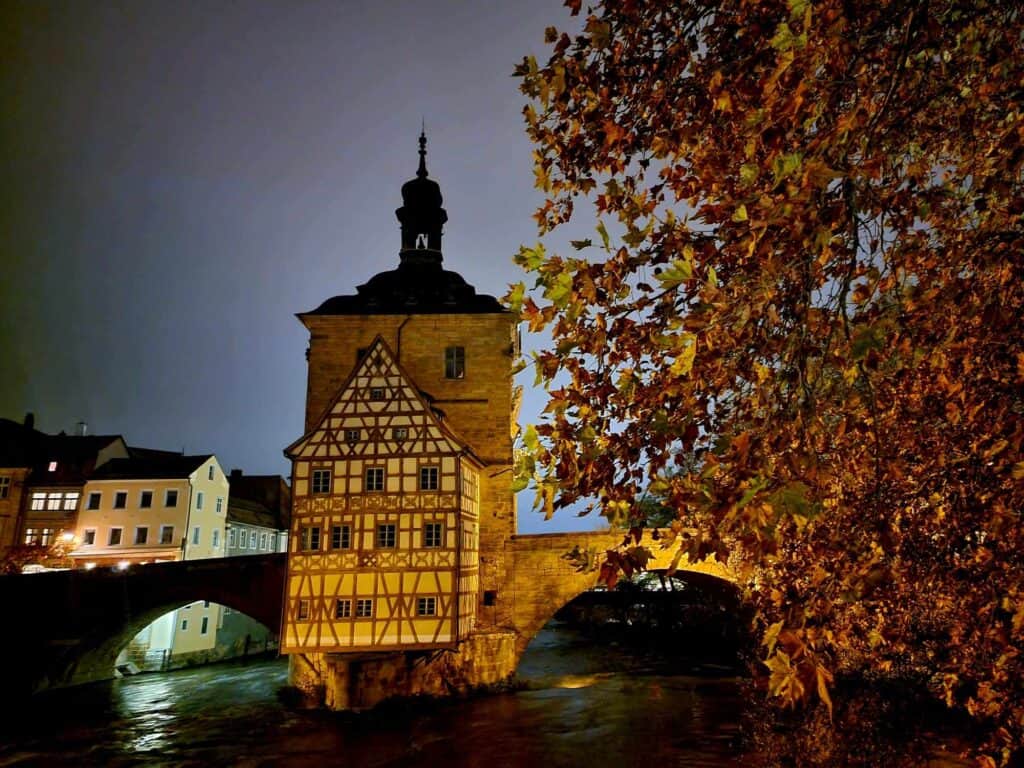
One day in Bamberg would not be complete without visiting the Altes Rathaus (Old Town Hall) – one of the most iconic buildings in Bavaria. There are a series of bridges over the Regnitz, and little dams and waterfalls all in a row. Talk about a photo opp! Magical!
History and Construction
The story goes that in the late 14th century the townspeople of Bamberg wanted to build a Town Hall, but the bishop of Bamberg, who held power in the region, refused to grant them land to build on. So the residents of Bamberg took matters into their own hands, and drove huge wooden pilings into the river bottom, creating an artificial island where they built the Town Hall. Problem solved! This unorthodox building method of creating “land” on water with wood pilings was also used to build the city of Venice in Italy!
Much of the Town Hall’s appearance today is the result of a reconstruction in the 18th century which added elaborate Baroque and Rococo elements to the original Medieval structure.
Its exterior is covered with colorful orange-toned frescoes depicting scenes from Bamberg’s history by artist Johann Anwander. There is also a beautiful small Rococo balcony.
Ludwigsbau Porcelain
The “bridge room” in the interior of the Town Hall is the home of the Ludwigsbau (Ludwig Collection) featuring fine porcelain and other artifacts collected by Ludwig I of Bavaria (the grandfather of Ludwig II who built the famous Neuschwanstein Castle). However, extensive and drawn-out renovations of the Town Hall means that this room has been closed off for quite a while. But the building is still very much worth seeing from the outside!
6. The Old Court (Alte Hofhaltung) and History Museum
Domplatz 7
20 minutes for the court / 1 hour for the museum


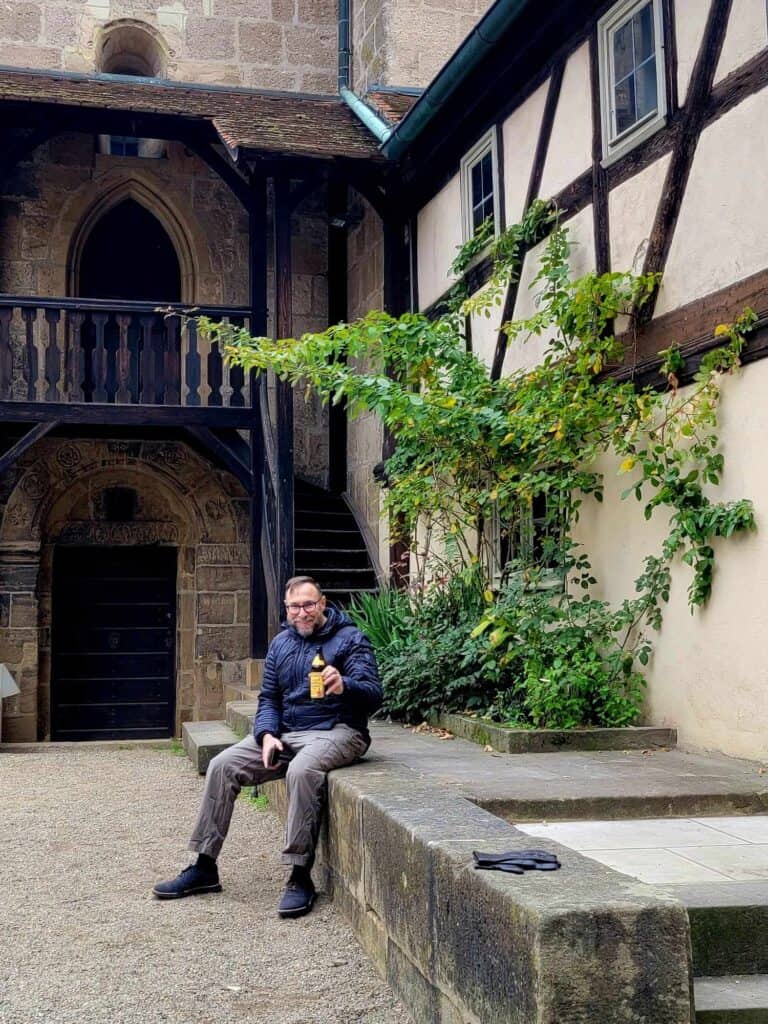
The Alte Hofhaltung (Old Court) will seriously blow your mind. When I walked through the gate I felt like I’d walked on to the set of a movie, so it was no shock when I discovered that this remarkable medieval complex has been used for just that purpose! The Three Musketeers (2011) filmed in the Old Court and all around Bamberg, and the historical drama Luther (2003) used the Old Court to film many scenes. And loads of German television series and historical dramas have filmed here and in other parts of the old town because it provides such a perfect medieval backdrop without much need for modification!
If this intrigues you (and you understand German) and you love cinematic history, there’s even a cinematic tour of Medieval Bamberg you can take which will walk you through all the places that have appeared in films over the years. You’ll hear all the behind-the-scenes stories and connect the dots to the places that have appeared on the silver screen! It takes about an hour and a half, so it’s suitable for a day trip, and it’s a screaming deal!
The Old Court complex was ordered to be built by Emperor Henry II in 1007, and served as the residence and administrative headquarters of Bamberg’s prince-bishops from the 11th to the 17th century. That’s when they built the opulent and luxurious ‘New Residence’ right across the street, and moved over there.
The Old Court’s main entrance is through a gate that transports you into a serene, almost etherial inner courtyard. At the gate is a cool little unobtrusive gift shop that sells a variety of local products with a medieval flair which you should check out before you leave.
The Old Court served as the residence and administrative center for Bamberg’s prince-bishops from the 11th century until the early 17th century. The bishopric of Bamberg was established in 1007 by Emperor Henry II, who initiated the construction of a residence for the bishops. It also served as a workshop and storage for religious works of art.




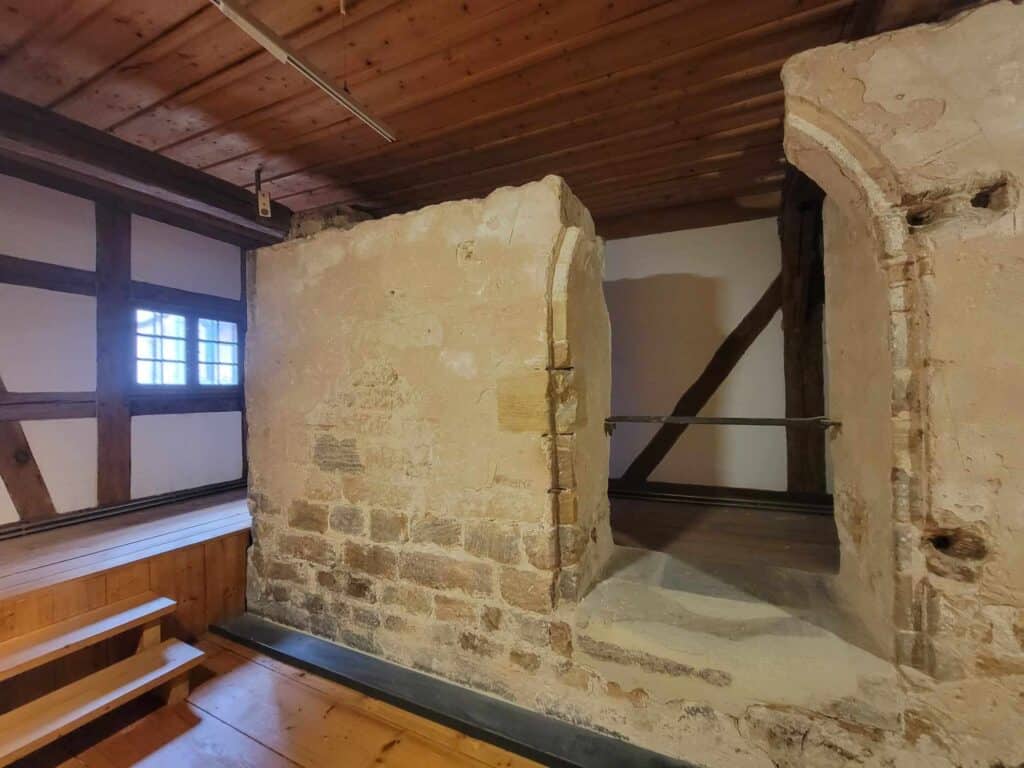

Part of the building complex now houses the Bamberg Historical Museum (Historisches Museum Bamberg) which displays a variety of exhibits covering Bamberg’s history and cultural heritage, and focusing on its important role as an ecclesiastical center through the ages.
The permanent collection includes an impressive selection of Medieval, Renaissance, and Baroque art including: portraits, ivory sculptures, coins and medals, tapestries and textiles, ceramics, and items related to Jewish life in Bamberg.
In addition to the displays, it’s interesting to be able to walk through the building as well, getting tantalizing glimpses of old doors and stairwells and other interesting structural aspects.
Access to the Old Court courtyard is free, but the museum is not.
Regular admission
– Adults: 10 €
– Children and young people up to and including 18 years: free
Domberg Combo Ticket (includes Diocesan Museum, Historical Museum, and the New Residence) €12
Opening Hours: Tuesday – Sunday 10:00am – 5:00pm
Check out the museum’s website for more details.
7. New Residence (Neue Residenz)
Domplatz 8
2 hours, or 45 minutes for just the apartments and the Kaisersaal




“The New Residence” as you might gather from its name, replaced the Old Court as the Prince-Bishops’ residence and administrative HQ. It is part of the city’s UNESCO designation and you really shouldn’t miss it. It was commissioned and construction began in the early 1600s. It was designed to be magnificent – a showcase of Bamberg’s religious and political power.
It’s final over-the-top Baroque touches were added in the late 1600s, and the results did all they were intended to do in terms of creating an opulent and ostentatious display.
The palace contains more than 40 rooms including ornately decorated state rooms, private apartments, grand reception halls, and the most magnificent of all – the Kaisersall (Imperial Hall). My jaw literally dropped.
The New Residence served as the home of Bamberg’s Prince-Bishops until it was secularized in 1803. Today it operates as a museum. There is also an unbelievably impressive collection of 16-18th century paintings including from Lucas Cranach the Elder and other German and European masters. It was really incredible.
Most of the rest of the enormous building houses the Bavarian State Library and various administrative offices.
And don’t neglect a visit to the stunning rose garden filled, of course, with roses! There’s also an impressive collection of Baroque statues, but after October they are enclosed in little wooden sheds to prevent damage from freezing water and exposure to the elements in winter.
Admission is €6 for adults and they do not accept credit cards, so be sure you have cash. Also bags and backpacks must be stored in lockers by the ticket desk which require a 1 euro coin deposit so have a coin with you as well.
Domberg Combo Ticket (includes Diocesan Museum, Historical Museum, and the New Residence) €12
April – September
Monday – Sunday: 9:00AM to 6:00PM
October – March
Monday – Sunday: 10:00AM to 4:00PM
Check the official Neue Residenz website for further details including renting out the Kaisersall for your event! Can you imagine?
8. St. Michael’s Abbey (closed for renovation)



History
St. Michael’s Abbey sits atop Michelsberg Hill, one of the seven hills in Bamberg. A former Benedictine monastery, it was founded in the 11th century, and is still a commanding presence in the town – scaffolding and all.
It was founded around 1015 by the Emperor Henry II, who envisioned Bamberg as a spiritual and educational center in the Holy Roman Empire, and is responsible for much of its character today!
St. Michael’s became one of Bamberg’s most prominent religious sites, and the monks were involved in local education, the creation of religious art, and ecclesiastical administration. The abbey was not only a place of worship, but a center for learning and manuscript production.
A fire in the 17th century forced a restoration and Baroque and Rococo embellishments were added, but it still retains its old Romanesque core.
Restoration
The Abbey has been undergoing extensive restoration work since… 2016! This huge undertaking is focusing on preserving the abbey’s structural integrity, and restoring the frescoes, architectural stone work, and sculptures. The abbey has been standing for a thousand years, so aging, shifting foundations, water damage, and environmental degradation were taking a toll.
When the restoration is all done, it is sure to be a spectacular revelation! The restoration has experienced a few delays, but they are aiming to have at least some areas of the abbey open in 2025 for a 1000th Anniversary celebration.
In the meantime, you can still enjoy the beautiful panoramic walk to the abbey, through wooded areas, past a vineyard, and to the Michelsberg terrace with breathtaking views over Bamberg. It also houses the Brewery Museum, which has remained open.
9. Franconian Brewery Museum (Fränkisches Brauereimuseum)


Michelsberg 10f
Still haven’t gotten enough beer history?
The Franconian Brewery Museum is located on the grounds of St. Michael’s Abbey, inside the courtyard in the abbey’s former cellars and storage rooms. This museum celebrates the long tradition of brewing in the region. Franconia is known for having more breweries per capita than anywhere in the world, so they know their stuff, and this is a must-visit for beer enthusiasts.
With vaulted ceilings, and thick stone walls dating back to Medieval times, it’s the perfect spot to really feel like you are stepping back in time and experiencing what it was like in the old brewery of the monastery.
Of course the museum displays all kinds of artifacts from Bamberg’s brewing past – kettles, barrels, fermentation tanks, and beer steins, mugs and glassware. You’ll see the progression of brewing from the Middle Ages through modern times.
And you will definitely leave with a new appreciation for the art, culture, and science of brewing beer!
Adult admission is €4, and family passes are €7.
The museum is open from April through October:
Wednesdays – Fridays 1:00pm to 5:00pm
Saturdays, Sundays and holidays from 11:00 am to 5:00 pm.
Check out the Fränkisches Brewery Museum’s website here for more details.
10. Walk the Old Town









This sounds like vague advice, but even if you just have one day in Bamberg, don’t neglect to allow some time for spontaneous discovery. If you’ve ever imagined using a time machine to travel back to the Middle Ages, this is as close as you’re ever going to get. Every building is different and intriguing. Each cobblestone street winds to places unknown, and every stairway delivers you to a new and spectacular place.
There are gates, and arches, and sculptures, and engraved markers, and fountains, and old walls, and I could go on and on…
Look at the buildings for dates to see when they were built, or placards that tell you what they used to be. We made so many cool discoveries this way – all unplanned and all amazing. We even found a bakery from 1427 – the Hof Bäckerei Seel right near the breweries that serves up Bamberg’s famous hörnla which is a croissant-like pastry that’s buttery and soft and fabulous.
11. Boutique Shopping Galore


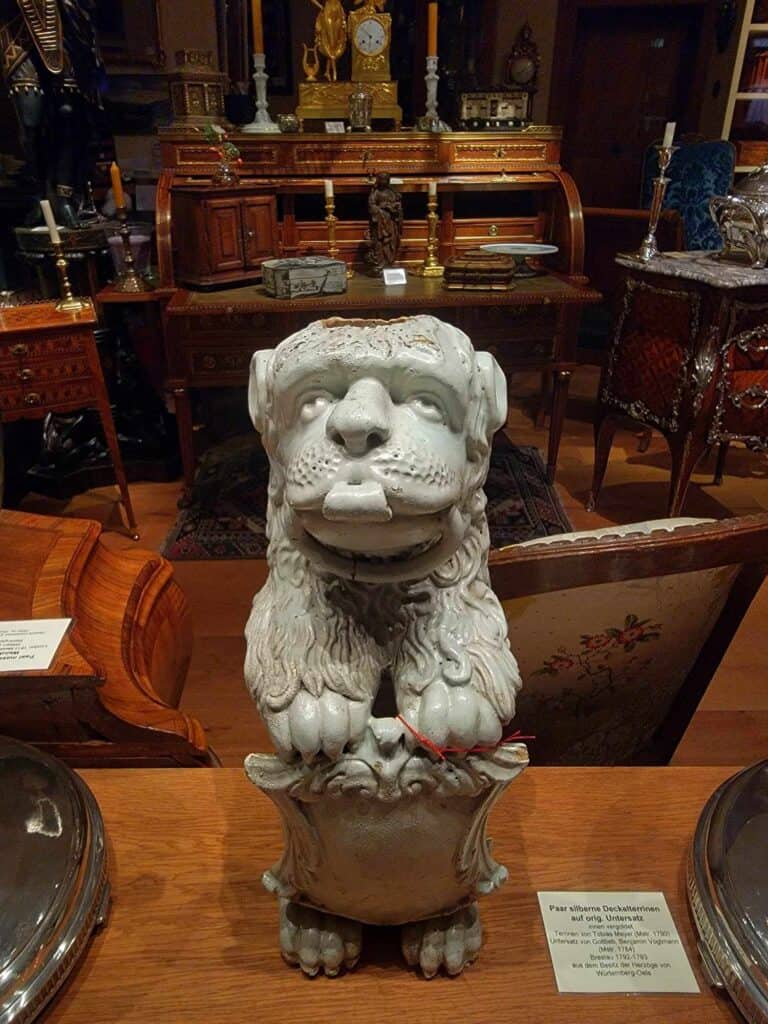
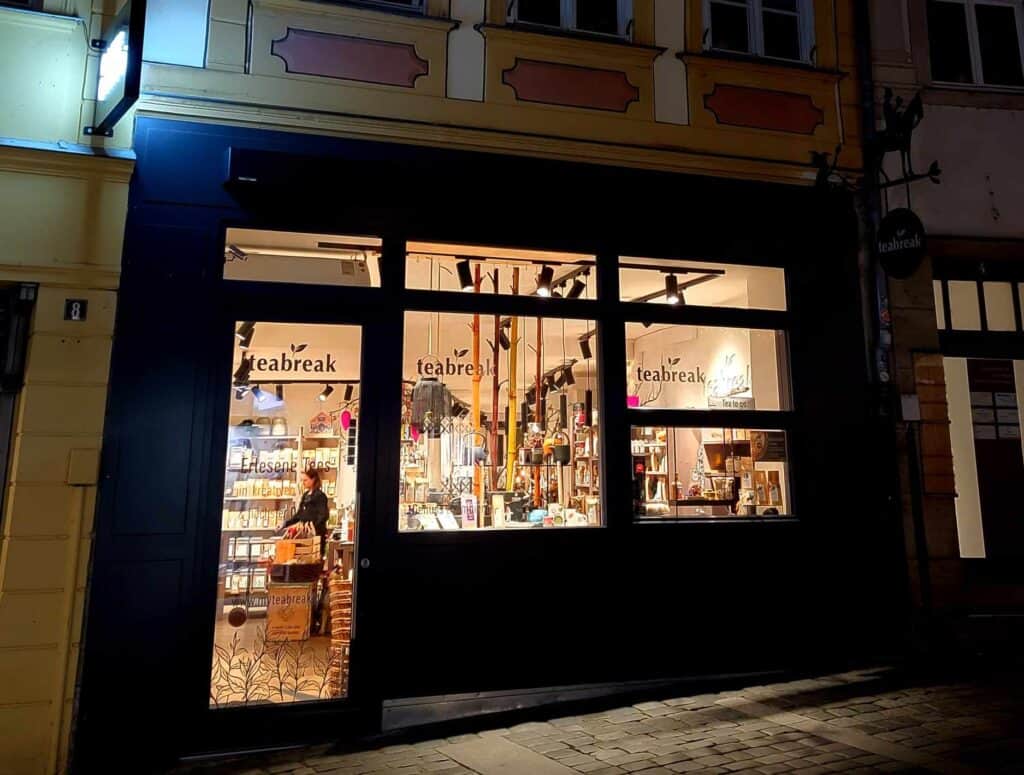


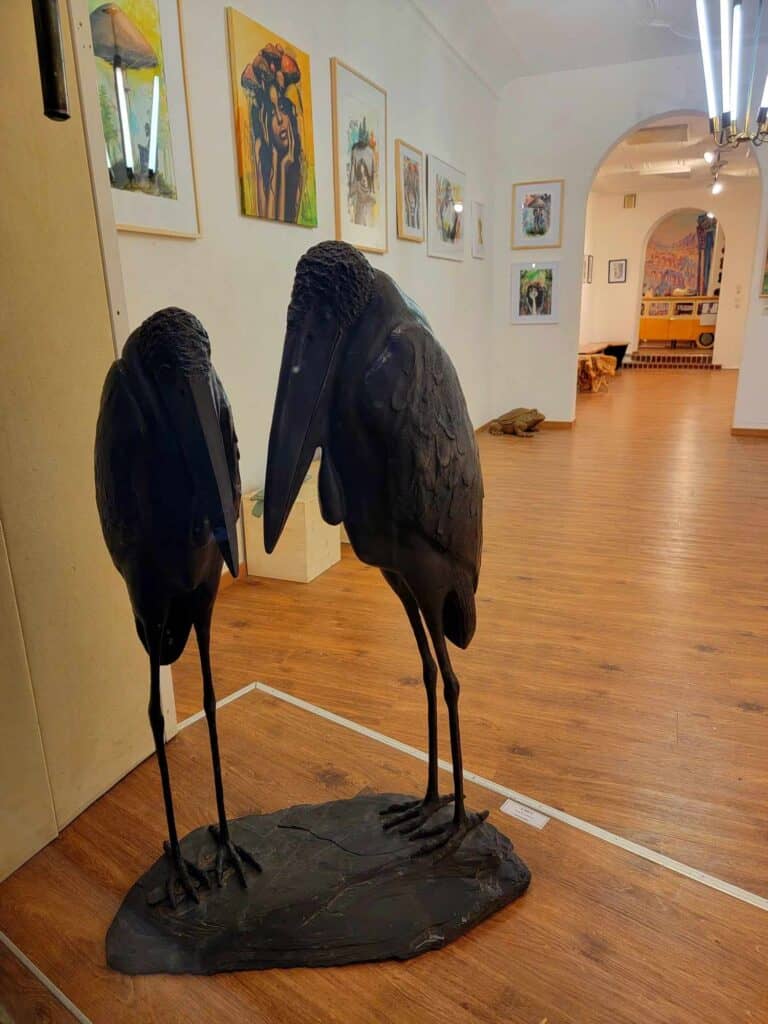
Even if you’re not a “shopper,” Bamberg will delight you with its absolutely charming shops that line the streets of the old town. There are a couple touristy spots with the usual mass-produced fare, but overwhelmingly shops and galleries inhabit old half-timbered buildings and cozy spaces, and sell unique high quality goods.
There are florists, clothing boutiques for men and women, baby stores, antique shops to die for, leather shops, secondhand and antique books, tea and coffee shops, craft stores, woolens, home decor, art galleries and more.
12. Altenberg Castle
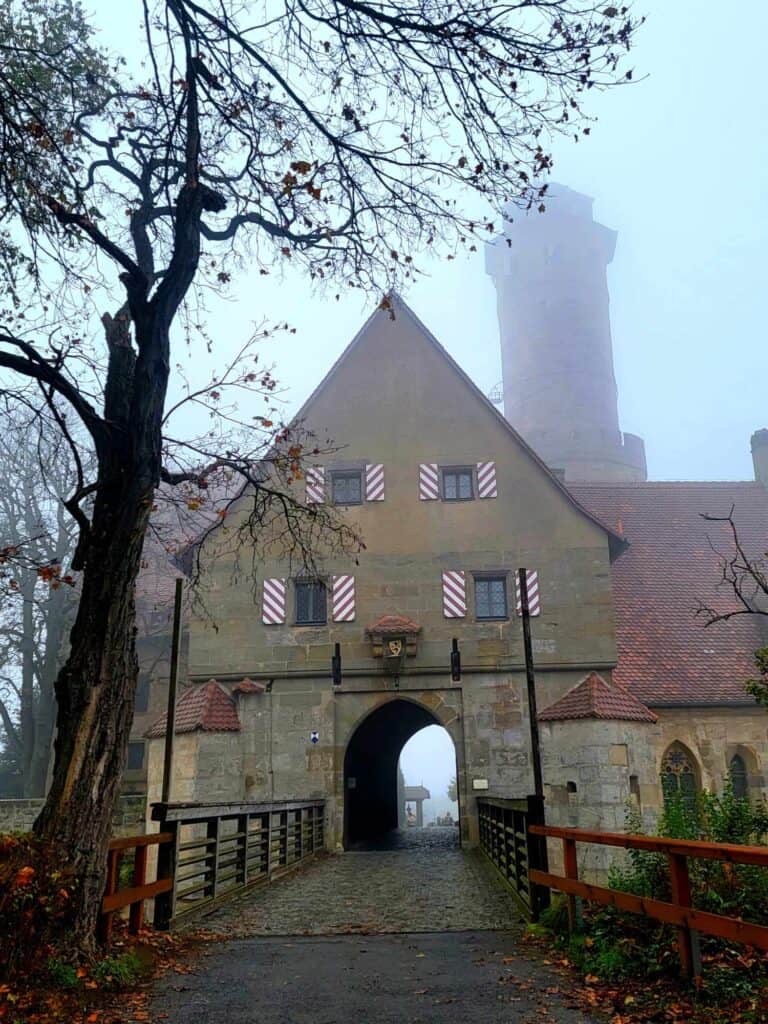




Altenburg Castle (Burg Altenburg) is a little off the beaten path, but a fascinating stop! Altenburg is a well-preserved medieval fortress perched on the tallest hill in Bamberg. The strategic views from the castle and its tall towers helped in its defense.
It was first mentioned in 1109, but may have been built on the site of an even earlier castle.
Since then Altenburg Castle has served various roles, from a defensive fortification and military stronghold which allowed residents to take refuge in times of conflict, to the bishops’ residence. It is now one of Bamberg’s most iconic historical landmarks.
In the mid-1500s it suffered extensive damage during the Second Margrave War, and only the chapel survived. You can still see that original 12th century chapel today, just as you enter the castle complex on the right. Over the subsequent centuries the castle was still used as a lookout, and eventually restorations in the 19th and 20th century have restored it to its former glory.
You can go inside the castle which now contains “Restaurant Altenburg” during the summer months, but it is designed mostly to be enjoyed from the outside. One notable exception is the observation tower which you can climb after putting one euro in the honesty box on the steps.
The castle sits on a network of hiking trails, and you can either hike up to the castle from town, or utilize the parking lot which will get you about 1/4 mile away.
13. Little Venice

“Little Venice” (Klein Venedig) is a charming riverside district in Bamberg, known for its picturesque half-timbered houses lining the Regnitz River. The nickname “Little Venice” came to be apparently because of the houses which sit right at the edge of the canal. Other than that it has no resemblance to Venice, but it does make for a beautiful view from the Oberbrücke (bridge), from a sightseeing boat, or a stroll through the neighborhood on the opposite bank.
The houses you’ll see are mostly private residences, and their beautiful colors and brimming flower boxes in the summer are utterly charming. As if Bamberg could possible be even more quaint and photogenic!
14. Hegel House



Nerd alert! This interesting building is called the House of Krebs (Latin for crab) with a lobster over the door. In Medieval times, houses didn’t have numbers, they had name designations which were often animals. The animals, sometimes real and sometimes mythical, would be used to symbolize something about the owner – wealth or bravery for instance. And sometimes they had to do with the profession of the owner. There isn’t much information about the House of the Crab, but perhaps its former owner made a living from the river somehow. All this is speculation.
What is not speculation is that the House of the Crab is where renowned that renowned philosopher Georg Wilhelm Friedrich Hegel! He lived here from 1807-1808 while he was Editor of the Bamberger Zeitung, where he published his ‘Phenomenology of the Mind.’ So, philosophy nerds will want to pass by and tip their hat.
3 Suggested Itineraries for One Day in Bamberg
Bamberg has so much to offer, it’s helpful to decide ahead of time which things you want to focus on. Are you a history buff and museum lover? Are you all about the beer? Do you want to shop and wander but aren’t really into museums?
Knowing what is close together will help as well. The three main areas to focus on are:
- The Cathedral, the Diocese Museum, the Old Court, the Historical Museum, and the New Residenz which are all very close together.
- The breweries Schelenka, Alte Ring, and Ambrausianum, and the Bäckerei Seel are all within feet of each other. And the Old Town Hall, the bridges, and views of Little Venice are very close by.
- Michelsberg panoramic walk, St. Michael’s Abbey, and the Brewery Museum are all connected.
Here are three suggested itineraries to get you started with your planning. Each represents one comfortable day. Of course, if you have more than one day in Bamberg you can either slow down the pace, or add things to your itinerary, or both!
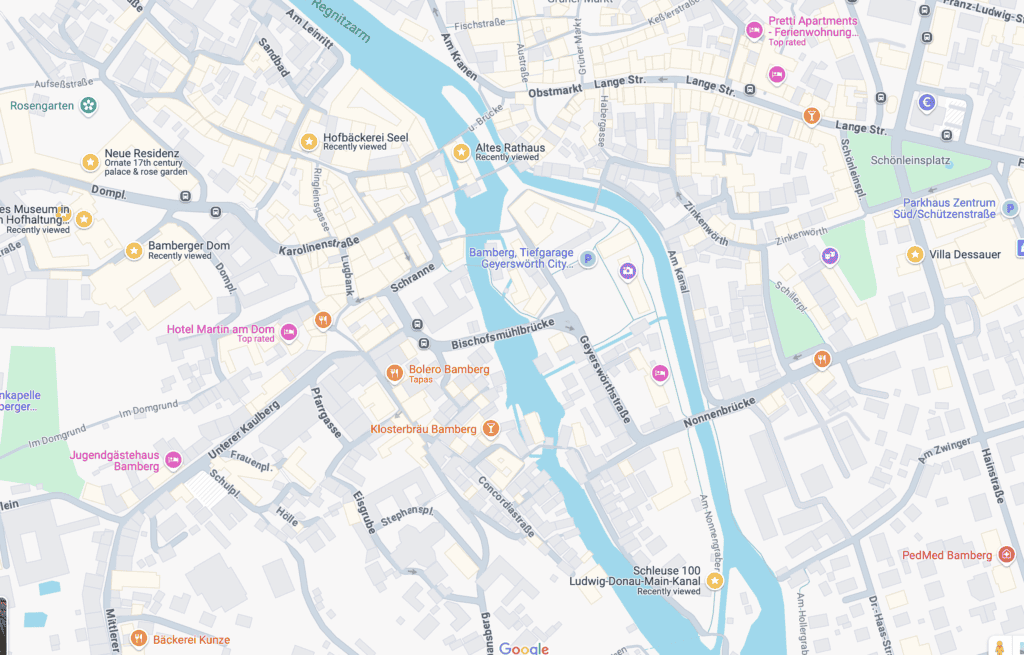
👑 Art and History Lovers Itinerary
Start your day at the oldest and best bakery in Bamberg, Bäckerei Seel for a cup of coffee and try Bamberg’s signature pastry, the croissant-like buttery hörnla.
Head right to the cathedral and spend an hour inside admiring the artworks and the architecture. Don’t miss the horseman, the tombs of Henry and Kunigund, and the tomb of Pope Clement II.
The Diocese museum can be accessed from the cathedral. Check out the amazing collection of medieval treasures: textiles, liturgical vessels, and the unique collection of relics.
From the cathedral you are just steps away from the Old Court. Take a few minutes to soak in the atmosphere, and then head into the Historical Museum where you can spend about an hour and a half
Time for a big lunch at the brewery! Choose one of the three I mentioned which are right in the Old Town and about a 10 minute walk from the Historical Museum.
Enjoy a stroll through the Old Town, find the Hegel House, the old Synagogue next door to it, and check out the famous and iconic Town Hall and get some photos.
Now it’s back to the Cathedral square, but this time you’ll head across the road from the Old Court to the New Residenz. Depending on how much time you have, you can walk through the stunning Kaisersall and the apartments, or you can do the whole museum including the incredible galleries of Old Masters paintings from Germany and the rest of Europe.
🍺 Beer Lovers Itinerary
Sponsored content: this section contains affiliate links
Start your day at the oldest and best bakery in Bamberg, Bäckerei Seel for a cup of coffee and try Bamberg’s signature pastry, the croissant-like buttery hörnla.
Meet your tour guide for the Beer tour which will take you to a local brewery, provide history and stories about Bamberg beer culture, and participate in 3-4 beer tastings.
Take the Michelsberg panoramic walk up to the St. Michael’s Abbey complex and check out the Brewery Museum for an hour or so.
Head down to the Old Town and enjoy a hearty German lunch at one of the three breweries I mention above.
Take a walk through the Old Town and over the Oberbrücke to see the historic Town Hall Building
With your remaining time, you can pop into the cathedral, wander around the Old Court next door, and go across the street to the Neue Residenz to check out the splendid Kaisersall.
Don’t forget to pick up a souvenir six pack of rauchbier before you go! You can find it at the gift shop in the Old Court, or ask your beer tour guide where the best spot is to find it.
🚶Shoppers and Wanderers Itinerary
Start your day at the oldest and best bakery in Bamberg, Bäckerei Seel for a cup of coffee and try Bamberg’s signature pastry, the croissant-like buttery hörnla.
You’ll be right in the heart of the Old Town, so spend a few hours window shopping, browsing, and buying to your heart’s content. If you’re looking for typical souvenirs they’re right across from the bakery.
Check out the Oberbrücke and the famous Town Hall building and get some pictures while you are there.
Stop at one of the three breweries I mention above for a hearty German lunch and sample the smoked rauchbier.
Work your way over to the Cathedral and spend a few minutes walking through it, then check out the Medieval Old Court right next door.
After that you can go across the street to the New Residenz. Even if you’re not a “museum person,” check out the incredible Kaisersall and the apartments, and the rose garden which will take about an hour.
Wander up the Michelsberg trail past the vineyards to the abbey and to the beautiful terrace overlooking the city.
Then explore the beautiful neighborhood of Little Venice. Walk by the canals and check out the amazing homes and gardens. Find Lock 100 and read the placards. The walk to the lock is beautiful and peaceful, right by the canal.
How to Get to Bamberg
🚗 By Car
- From Munich – 2 hours by car
- From Frankfurt – 1 hour 56 minutes by car
- From Nuremberg – 42 minutes by car
- From Würtzburg – 50 minutes by car
- From Erfurt – 1 hour 43 minutes by car
🚉 By Train
- From Munich – 1 hour 43 minutes by train
- From Frankfurt – 2 hours 46 minutes by train
- From Nuremberg – 37 minutes by train
- From Würtzburg – 55 minutes by train
- From Erfurt – 43 minutes by train
✈️ Closest Airports to Bamberg
The closest airports to Bamberg are Frankfurt (FRA), Munich/München (MUC), and Nuremberg/Nürnberg (NUE)
Enjoy Your Trip to Bamberg!

Whether you have only one day in Bamberg, or if you’re lucky enough to stretch it to two or even three, you’ll have to work to not have a great time. Finding an original Medieval town in Germany feels like finding a unicorn, and it really offers an unequalled look a thousand years into the past.
Walk the streets of Emperor Henry and Empress Kunigund, visit the ancient cathedral and the miraculously preserved Old Court. And of course indulge in the extravagance of all the Rococo palaces, facades, and gardens while you enjoy the best beer Germany has to offer. It’s a city not to be missed!
Other City Guides to Hidden Gems in Europe:
- 46 Best Things to Do in Rothenburg ob der Tauber
- 25 Best Things to Do in Nuremberg: History and Hidden Gems
- 21 Best Things to Do in Kaiserslautern Germany
- 11 Best Things to Do in Trier, Germany
- One Day in Aachen? Discover the Treasure!
- 11 Best Things to Do in Marburg, Germany’s Fairytale Town
- The Perfect Weekend in Cologne, Germany
- The 12 Best Things to Do in Epernay France
- 12 Incredible Things to See in Metz, France
- Ostuni the White City: Your Magical Gateway to Puglia
- The 7 Most Amazing Things to Do in Ravello Italy
- 20 Amazing Things to Do in Poznan, Poland!
- Altdorf Switzerland: Discover Where William Tell Shot the Legendary Apple
